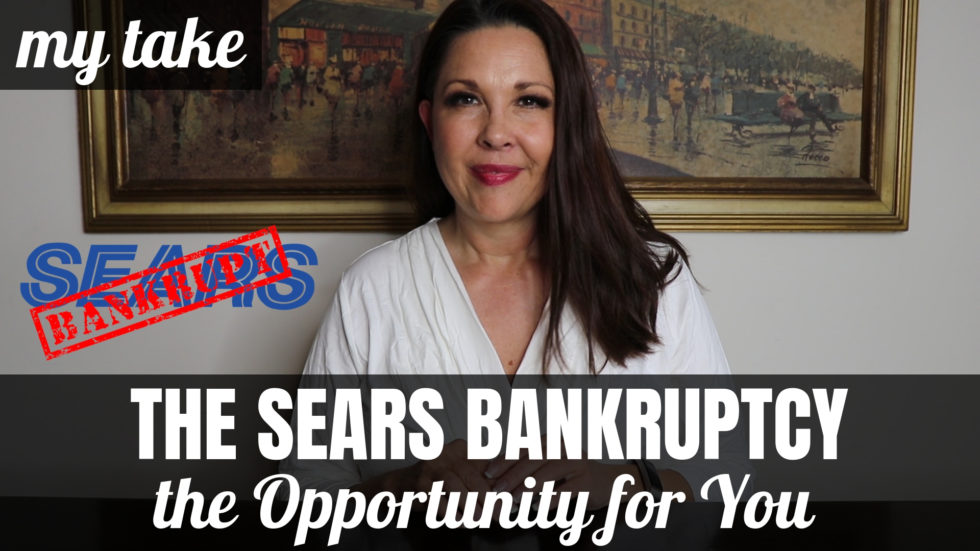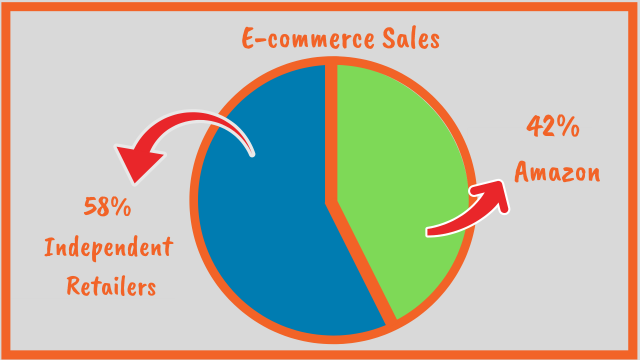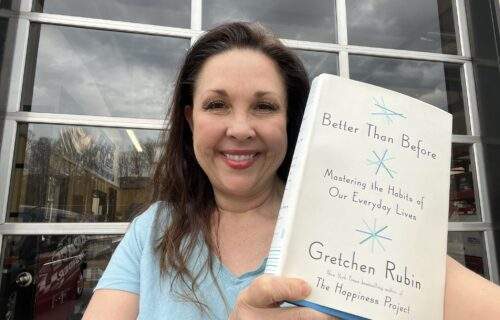
Sears Bankruptcy | It’s Not All Amazon’s Fault
This is my take on the Sears Bankruptcy and the 4 factors that led to it. It’s not all Amazon’s fault.
The 4 factors include:
1. Store Design
2. The Hedgefund Manager
3. Lack of specific branding
4. Amazon and E-commerce trends
Transcript:
Hey there! Today I want to give why my take on the Sears bankruptcy and why I think now is the best time ever to start your own online store. Now in case you hadn’t heard, Sears declared bankruptcy earlier this week, and a lot of the headlines keep saying that it’s all Amazon’s fault. Amazon is really the culprit in all of this.
Now, there’s a little bit of truth to that, but it’s not really the whole story, and I think I have a little bit of a unique perspective on this whole situation. I’ve never worked for Sears or anything like that, but my background includes interior design, I’m a marketer, and I’ve also been a stock market investor for a long time. So with that, I think there are four factors that really played into the Sears bankruptcy and that really release an opportunity for you today.
Four Factors of Sears Bankruptcy
1. Store Design
So first of all, let’s talk about design. Now, these stores, I seriously hadn’t been in a Sears store in I can’t even tell you how long. It’s been a really long time, but when we think of Sears, we also think of Kmart because they became part of the same umbrella, and I have been in a few Kmart stores, and they’re just dingy. When we think at the Kmart versus Walmart, you’d walk into a Kmart and they’ve got the drop ceilings and colors from the 70s or 80s, whereas when you walked into Walmart they had these open ceilings, and really bright and white and clear. So when you look at those two stores, if you were to walk into one and then walk into the other and then ask any customer which one they’d rather shop in, Walmart was the clear answer from just an aesthetic standpoint.
The same thing can really be said about the Circuit City versus Best Buy. I know that’s been a while ago, but I remember walking into those stores, the Circuit City stores even though I’m not a fan of Best Buy, but when you’d walk into a Circuit City store, you just felt like closed in like you were in a closet, and they just didn’t stay in tune with what was happening in the design world. Regardless, it really does play a psychological effect on a shopper. So that’s one piece of it that nobody is talking about and I always felt the same way in a Sears store. It just felt old or dingy or something.
2. The Hedgefund Manager
Now that brings us to the second point, and the second point is when these stores, like the Sears and the Kmart, they were taken over by a hedge fund manager, and I do have experience as a stock market investor seeing a company being taken over by a hedge fund, purposely run into a ground so that they can steal the money from the shareholders, and in this case in the Sears case, it’s also probably going to come out of the pockets of the pensions of the employees, which is just terrible, and it does not make me happy.
One of the things the hedge fund did is they separated all of the companies that Sears owned, including Craftsman Tools, and they had owned some other specialty apparel shops, and they split that all up so that one couldn’t actually help out another. So the hedge fund, I think that has a much larger part to play in all of this that barely anyone is talking about.
3. Lack of specific branding
Now number three here is let’s talk about the brand for a minute here. I mean this is a brand that’s been around, I didn’t look up when they started, this is like a hundred and something year old company I think. They’ve been around forever. However, things have changed today, and they’ve changed a lot, and especially changed since 2008.
Today you have to be very clear in your branding, very clear in who your customers are, and I think they try to kind of be kind of everything to everybody. They try to sell kind of everything but with no focus on really in particular thing.
So for me, they were certainly last. I mean if you were to give me a list of brands and say, “Hey, which one of these is the most vanilla?” Honestly, I would pick them off of a list. But if you were to ask me a blank question, I don’t know if they’d even come to mind.
I certainly didn’t see them on the internet. I’m on the internet of course a ton, and I haven’t seen an ad for Sears in forever. So they just didn’t keep up with the times.
I think, well it’s not even what I think, the statistics show that we really want a very much more personalized experience. We want exactly what we want and how we want it and all of that, and it’s really hard for brick and mortar stores to really be able to do that.
I mean to give you an example, actually I’ll say this example now, but this summer I was looking for a gazebo for my patio and I tried to shop locally. I shopped at Big Lots and I went to Lowe’s, I went to Walmart, and none of them had the right thing for me and I ended up shopping on Amazon to get it.
4. Amazon and E-commerce trends
So that does bring us to the number four point, to Amazon. What is their kind of role in all of this? Well let’s back up for a second and let’s look at Sears. I mean for goodness sake, they were the catalog retailer of all catalog retailers back in the way early 1900s. Come on, if there was anybody who should’ve been at the cutting edge of being online, I mean you’ve got a company who owns the Sears Tower for goodness sake. It’s one of the tallest buildings in the world, or at least it was at one time, I know there are a lot of taller buildings now.
But this was really a huge company and they couldn’t see that coming?
“You know hey, maybe we should take this catalog thing and go really big onto the internet.”
But with Amazon, there’s a few different things about Amazon. Now number one, I think they have done a fantastic job of building a really big tent. Because not everything that you buy on Amazon actually comes straight from Amazon. It really is from a lot of small retailers. I mean for instance, my E-commerce store, I have items that I offer on Amazon as well.

So Sears, keeping it enclosed like that, rather than having a huge network and building a bigger tent, I think that hurt them. When we talk about Amazon, let me throw out a stat here for you. In 2017, 42% of US E-commerce sales happened on Amazon. I saw that on internet retailer. That’s huge obviously, that’s a big number. But, there’s still more business out there. So 42% means 58% went to independent retailers, or other retailers other than Amazon, so you don’t have to be Amazon today.
So let’s talk about that opportunity for a moment because of course the best time to start an online store was probably five or ten years ago. But you know the second best time? Today. Today is the next best time to start this. You really don’t want to be looking at this five years from now and thinking “Oh man, I probably should’ve done that maybe like five years ago.” No, do it now. There’s so much opportunity. I mean I talk about E-commerce a lot, I love it, it’s changed my life, I mean it is my life and I am so happy that it’s the opportunity that we have today. So let’s look at the opportunity we have today as well as opportunities we have in the future talking about some more stats. So here we go,
..in 2017, there was 2.3 trillion dollars in E-commerce sales.
2.3 trillion dollars! So even if we take that 58% that is leftover after Amazon, and again, you can be part of Amazon’s tent, it’s not just all of theirs. That’s a lot of money. 2.3 trillion dollars. And then, check out this one.
By 2021, ecommerce is expected to be 4.5 trillion dollars.
Wow, that’s a lot of money. That’s what’s coming. It really depends on you whether you want to move forward with that.
I’ve got one more stat here too. So, let’s talk about the percentage of E-commerce verus retail stores. So if you’re a brick and mortar now, or you’re even thinking about that, brick and mortar is still a great place to be because in 2017 today, that E-commerce accounts for about 10% of retail sales. Now however, this is expected to grow by nearly 15% per year. So we’re going to see more and more of a shift to online sales, and lots more stats that, I didn’t bring all the stats in because I didn’t want to make you just like stats, to like episode, but there are a lot of stats about the preference of people shopping online versus shopping wherever they are and the time that they save, and when they can shop, and there’s a lot there.
So if you’re thinking about having your own online store, you can visit me at katedillon.com, join my email list, there’s some downloads that you can get over there on my site. In fact one right now is I’m talking about I’ve got an E-book that talks about creating your About Us page. It’s actually one of the most important pages on your website because you’re not Amazon. Why should people know, like and trust you? And why should they buy from you? So I’ve put together an E-book over there so that you can download that.
But, I hope this has been some great information for you, I’ve hope you’ve enjoyed watching, and if you like this video, please hit that subscribe button and like this video, and I will see you in another video.



